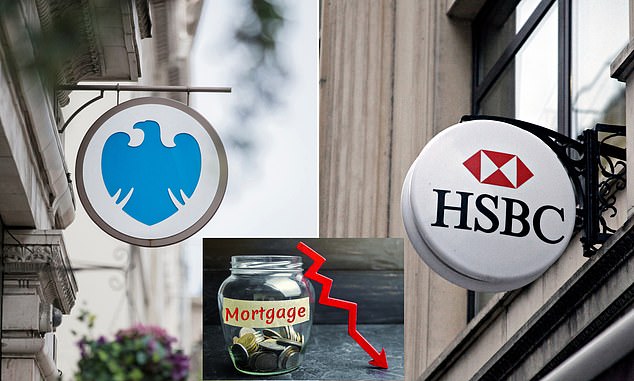Two major mortgage lenders have announced rate cuts, following three and a half months of steadily rising home loan costs across the market.
From tomorrow, HSBC and Barclays will slash rates on a number of fixed mortgage products aimed at buyers and remortgaging.
Average mortgage rates have risen steadily since early February, with most traditional lenders raising them several times, and mortgage brokers say today’s announcements could mark a change in direction.
U-turn: Barclays and HSBC have announced a wave of mortgage rate cuts
Since February, the cheapest five-year fixes have gone from less than 4 per cent to around 4.5 per cent and the cheapest two-year fixes have risen from around 4.2 per cent to 4.8 per cent. .
While HSBC will not reveal details of its rate changes until tomorrow, Barclays has said it will introduce some of the cheapest five-year fixes on the market.
Its lowest five-year fix for remortgaging is falling from 4.77 per cent to 4.32 per cent, with a fee of £999. Unless HSBC overtakes it, it will be a new best buy.
It will be available to people who remortgage when the amount of their mortgage does not exceed 60 per cent of the value of the property.
Someone remortgaging a £200,000 home loan with a 20-year term could expect to pay £1,246 a month.
To put this into context, the five-year average settlement is currently 5.49 per cent, according to Moneyfacts. That would cost someone with the same mortgage amount and term £1,375 a month.
Barclays is also cutting rates for those remortgaging with a loan-to-value ratio of at least 75 per cent. This is falling from 4.84 percent to 4.45 percent and will again be the best buy.
The lender is also cutting its lowest rates for home buyers who have at least a 40 per cent deposit, from 4.47 per cent to 4.34 per cent. These are priced at £899.
Home buyers with a 25 per cent deposit could get a bank rate of 4.44 per cent, down from 4.73 per cent.
While it has not revealed the new rates, HSBC said it was cutting a wide range of two-, three- and five-year fixed products.
This will benefit first-time buyers, those moving house and remortgaging.
Mortgage brokers have suggested this could mark a change in direction in mortgage rates, and other lenders are expected to follow suit.
Stephen Perkins, managing director of Yellow Brick Mortgages, told news agency Newspage: ‘Excellent news this morning with rate reductions from both Barclays and HSBC, which will revitalize a mortgage market that has been languishing for too long.
“This could be the spark that starts another mini dude war.”
Michelle Lawson, director of Lawson Financial, added: ‘Barclays is the first big gun to fire the rate-cutting cannon, quickly followed by HSBC.
‘These are also good reductions, rather than symbolic gestures, so we are now waiting for the domino effect that other lenders will follow.
“This is a much-needed positive attitude during what, for many borrowers, are very anxious times.”
Will mortgage rates begin to fall?
For mortgage borrowers, what comes next is best implied by Sonia’s swap rates.
Mortgage lenders enter into interest rate swap agreements to protect against the interest rate risk involved in providing fixed rate mortgages.
The rates they pay to do this are known as swap rates and show what lenders believe the future holds with respect to interest rates.
This, in turn, governs the prices that lenders impose on the mortgages they provide to customers.
As of May 1, five-year swaps were at 4.18 percent and two-year swaps at 4.68 percent.

Sixth time in a row: the Bank of England once again opted to keep the base rate at 5.25% earlier this month. We are unlikely to see significant cuts in mortgage rates until the base rate begins to fall
But they have fallen since the beginning of the month. As of May 14, five-year swaps were 3.97 percent and two-year swaps were 4.49 percent.
While this suggests that mortgage rates could fall, it may not be by significant margins.
Swap rates remain higher than at the beginning of the year, when two-year swaps were at 4.04 percent and five-year swaps at 3.4 percent.
If the base rate starts to fall, this could send good signals for the industry, meaning that swaps could also start to fall.
But that doesn’t necessarily mean there will be big rate cuts on fixed rate products right away due to the fact that lower rates have already been priced in because there is already an expectation that rates will fall.
Nicholas Mendes, mortgage technical director at John Charcol, said: ‘Following last week’s announcement that the bank rate would remain unchanged, there has been a notable shift in the swaps market.
‘Financial markets have adjusted their forecasts, signaling a possible end to the recent trend of lenders raising their rates.
“As most lenders have increased their rates in recent weeks, there is now significant potential for rate reductions in the coming fortnights.”
Some links in this article may be affiliate links. If you click on them, we may earn a small commission. That helps us fund This Is Money and keep it free to use. We do not write articles to promote products. We do not allow any commercial relationship to affect our editorial independence.



